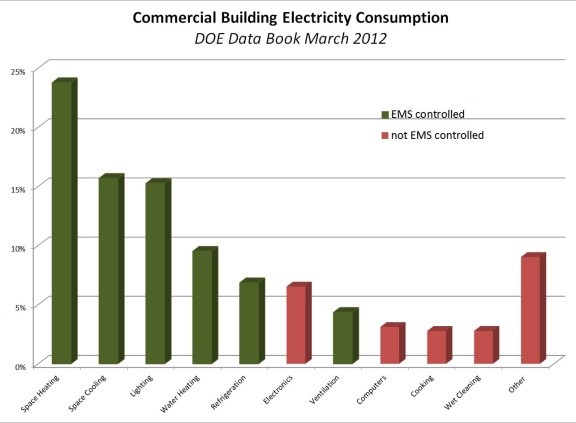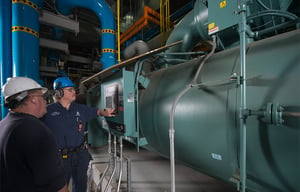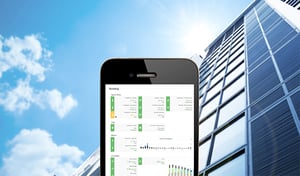HVAC systems represent a key part of the building commissioning (Cx) process. Not only do HVAC systems impact one of the most critical areas of perceived tenant comfort, but HVAC systems also represent a large share of the ongoing energy consumption costs in the building. HVAC systems are key to building performance and sustainability.
HVAC commissioning represents a part of the general building commissioning process, which focuses on the validation, verification and documentation of the building specifications relative to the owner’s project requirements (OPR). In short, the process confirms that the building actually works as originally designed prior to handover to the facility management staff. After initial fine-tuning and optimization, HVAC system performance becomes dependent on the performance of periodic service contracts.
What is Continuous Commissioning?
Scheduled performance checks on HVAC equipment do not necessarily equate to re-commissioning of the HVAC system. Performance of the HVAC system can drift over time. This can be due to insufficient maintenance or changes in the use of a building. Building areas that were once comfortable can become insufficiently or overly cooled/heated leading to occupant complaints. Certainly, energy efficiency would also decline.
Continuous commissioning formalizes the process of ensuring that your HVAC system runs at peak performance levels. This ongoing process is designed to resolve operational problems, improve tenant comfort, and optimize energy use for existing buildings. Continuous commissioning can also significantly extend the useful life of HVAC equipment.
The Federal Energy Management Program’s (FEMP) Continuous Commissioning Guidebook for Federal Energy Managers describes continuous commissioning as:
“An ongoing process to resolve operating problems, improve comfort, optimize energy use and identify retrofits for existing commercial and institutional buildings and central plant facilities. [It] focuses on improving overall system control and operations for the building, as it is currently utilized, and on meeting existing facility needs. It goes beyond an operations and maintenance program. It does not ensure that the systems function as originally designed, but ensures that the building and systems operate optimally to meet the current requirements.”
To truly impact building performance, continuous commissioning must take into consideration both occupant and investor requirements.
Glaring Need for Continuous Commissioning
As is well known, HVAC and lighting represent the largest percentage of the electricity consumption in commercial buildings. While every building’s consumption profile varies due to the differences in HVAC and lighting equipment, the theme remains the same. Energy efficiency efforts should primarily target HVAC and lighting sources of energy consumption.
 EXAMPLE OF HVAC AND LIGHTING COSTS
EXAMPLE OF HVAC AND LIGHTING COSTS
In most commercial and industrial facilities, chiller systems receive large amounts of investment, attention, and maintenance. Because they account for a large percentage of the utility costs in a build, their efficiency, or lack thereof, can have a huge impact on the operational efficiency of a building.
According to one report focused on real energy savings, chilled water plants can be labeled as “commissioned” yet perform sub-optimally. The report noted the results from several studies, which indicated major operational deficiencies from commissioned chiller plants:
- One study showed that chillers, which should be operating in a OEM specified range of 0.65-1.00 kW/Ton, were often exhibiting actual operation at 1.5-3.0 kW/Ton. The survey further noted that most chiller plant operators had no idea how well their chiller plants were performing.
- Another study of 14 chiller plants found that a substantial variation in chiller plant energy efficiency ranging from 0.55-1.80 kW/Ton.
- Yet another study addressed the problem that buildings and chilled water central plants do not perform as well in practice as is anticipated during design.
These operational deficiencies were largely attributed to (1) improper equipment selection and installation, (2) lack of rigorous commissioning and proper maintenance, and (3) poor feedback on operational performance and energy performance.
Clearly, more is needed.
Historical M&V – Reporting and Audits
The lack of visibility into a chiller plant after “commissioning” has led to Measurement and Verification (M&V) standards. These M&V standards seek to provide mandated submissions of periodic reports of chiller plant performance. The intent of such legislation is to ensure the auditing of HVAC system performance to determine compliance with energy efficiency standards throughout the life cycle of chiller plant performance. Certifications based on such compliance can feed into various rating schemes that champion environmental sustainability.
While scorecards are useful, their impact on the true efficiency of the chiller plant performance is muted. Periodic reports provide historical context. They have limited value in delivering real-time operational insights that can lead to true chiller plant optimization. Historical M&V has limited value in delivering on the promise of continuous commissioning.
The New Deal - Plant Virtualization
 Continuous commissioning formalizes an ongoing, uninterrupted process. Certainly, the best implementation of continuous commissioning would leverage truly continuous monitoring data from the chiller plant.
Continuous commissioning formalizes an ongoing, uninterrupted process. Certainly, the best implementation of continuous commissioning would leverage truly continuous monitoring data from the chiller plant.
Imagine, for example, that the monitoring system could capture the following data:
- Chilled Water Loop – Flow Rate, Pressure Drop, Supply/Return Temp, Supply/Return Setpoint
- Condenser Water Loop – Flow Rate, Supply/Return Temp, Supply/Return Setpoint
- Chiller – Status, Loading, Compressor Motor Input, VFD Control Status, Efficiency
- Cooling Tower – Status, Fan VFD/Multi-Speed Control, Entering Air Wet/Dry Bulb Temp, Leaving Air Wet Bulb Temp, Makeup Water Temp, Range, Approach, Effectiveness
Imagine further that the data was collected using monitoring equipment that was permanently connected to the chiller plant systems to enable continuous tracking and reporting in real-time.
Such an integrated chiller plant performance monitoring system implemented in the cloud enables virtualization of the chiller plant. Asset digitization of the chiller plant provides the framework for ongoing optimization by leveraging analytics based on real-time operational data. The historical collection of operational data enables predictive maintenance. IoT provides the fuel for Artificial Intelligence (AI) and Big Data. The increased availability of real-time data will facilitate AI tools such as machine learning. Anomaly detection and Fault Detection and Diagnostics (FDD) can signal the need for maintenance before catastrophic failures occur. Eliminating the risk of emergency repairs will have a far greater impact on your facility management budget as compared to energy efficiency savings.
Conclusion
Continuous commissioning addresses a problem most already know exists. Initially commissioned systems will have performance profiles that drift due to changes in the system itself or in the occupant requirements placed on the system. Effective management requires visibility to real-time operational data. Continuous commissioning should be the new normal.

